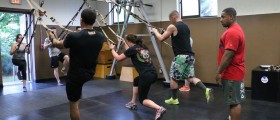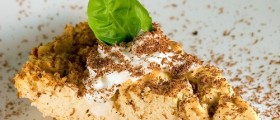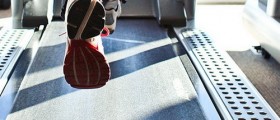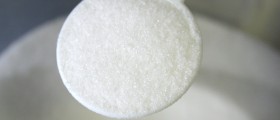At the moment, I do a simple 30 minute interval run before my workout (which I've mentioned in another thread), my aim is simply to lose a bit of flab (i'm not majorly fat, i'm just trying to loose the love handles ;)).
Anyway, the people in the bodybuilding forums tell me that the best way for this is to do short, high-intensity runs, whereas the people on this forum (i think!) are saying that longer, lower-intensity runs would be more beneficial.
Can someone put me straight please.. ? Thanks :D
(At the moment I am doing 1m run, 1m walk for 30mins, then 30 mins steady pace on the bike, 5 days a week)
Loading...
Short anaerobic bursts burn and use immediate energy sources. ie glucose and glycogen. When you use these sugars anaerobically you are not getting the most use of the ATP production. I won't go into the chemistry involved, but you know when you go hard for short distances you tire quicker and your muscles get weaker faster.
When you go slower, aerobic, the body use the stored energy sources as fuel. This does not happen overnight and will not happen in a few weeks. It takes the body along time to learn HOW to use fat as energy. When the body learns that it does not need to burn the glycogen stores, it will start to burn the stored fat and become a more efficient calorie machine.
Long distance runners count on this energy to carry them through the long runs. They cannot count on the 2000 calories of immediate use enrgey to carry them through, they train their bodies to burn the fat. Of course they have very little to burn, so they require a lot of different foods, but thats a different story.
Long, slow, aerobic runs will reduce the fat. Not overnight and not in a few weeks. Months.... and months.
Of course this is all mute if you eat bad in the interim. Any saturated fats and extra calories will immediately replace what you have burned and you will be back at square one.
I hope that helps.
Sheldon
Loading...
Loading...
basically put low intensity,49% and less of MHR burns more fat than glycogen/carbohydrates
51% and more burns more glycogen/carbohydrates than fat.
now the cause for the confusion is the more muscle you have the more energy required to fuel it. so.....it will burn more fat even at rest.
if you do not want to "bulk up" and just want to lose fat, stay under 50%
and i'll second the fact it takes time, patience, and perseverance.
good luck
Loading...
Loading...
No prob MED, i got your back covered. :thumbsup:
Loading...
Loading...
I'm not sure about the numbers, but in theory it works. I'm not sure about burning fat with more muscle too.
More muscle does burn more energy, but if that muscle goes anaerobic, then it is anaerobic and that definetely does not burn fat.
Exercise that is low HR, and long in duration is the only way to burn fat.
Sheldon
Loading...
Can anyone confirm that there is some truth to this? This doesn't match anything I've ever heard or run across in my studies... I am pretty sure the graph i have pictured in my head comes from the "Heart Rate Training for the Compleat id**t" but i know i have seen this around for years as well. the reason the "fat burning" zone on the Aerobic Machines is at lower pulse rates.
Loading...
Loading...
here's a link i pulled off my home PC. the guy has somesriuos credentials in the UK track & field arena
Intensity and Energy Source
The relationship between exercise intensity (% of your Maximum Heart Rate) and the energy source (carbohydrate and fat) is as follows:
Intensity % MHR % Carbohydrate % Fat
65 - 70 40 60
70 - 75 50 50
75 - 80 65 35
80 - 85 80 20
85 - 90 90 10
90 - 95 95 5
100 100 0
i see were i got the numbers slightly skewed but the premisce of what i was saying is there. 75% intensity is where ilike to keep myself normallyfor the LSD and i just associated it with the 50 percent mea culpa there.
Loading...
A whole different thing happens with burning fat at the end of a marathon. In marathon preparation, the idea is to teach your body to efficiently use fat as a fuel source in order to get you through a long race instead of as a tool to lose weight. Unless you are running quite fast, it is unlikely that your body has enough available glycogen stores to get you through a marathon. When these run out, you need to use fat energy (or eat gel packets) to get you through the later miles. This generally occurs with runs longer than 90 minutes, which is one reason it is critical to do long training runs. You don't need to run in excess of 90 minutes to lose weight, but you do need to run that long to train your body to use fat efficiently as a fuel source.
Loading...
At the higher intensity you are getting a net of 2-4 ATP from the cleavage of the glucose, you are getting more ATP from the same glucose when you are able to use the Krebs cycle.
I also agree 100% about the losing weight by running slower statement. The idea of fat buring is to get further with less intake, the amount of fat burned would be much greater if you (I cannot believe I am going to say this) lift weights and gain lean muscle mass.
Sheldon
Loading...
Loading...





_f_280x120.jpg)











